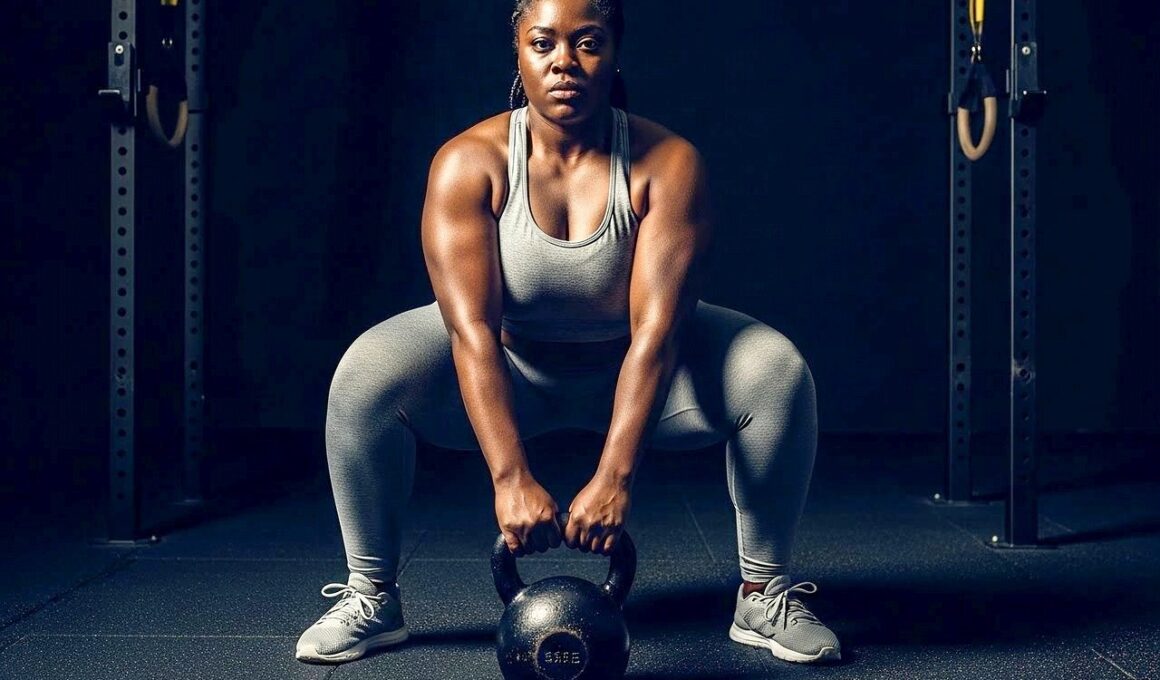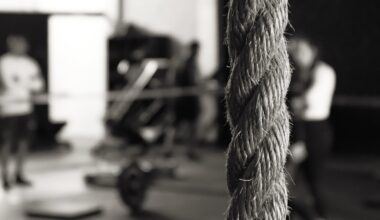Biomechanics of Resistance Training Exercises: Enhancing Technique
The biomechanics of resistance training is fundamental for optimizing athletic performance while minimizing injury risks. Understanding how the body moves during resistance training can lead to better outcomes for athletes and fitness enthusiasts. Key aspects to consider when analyzing biomechanics include force production, joint movements, and muscle activation patterns. Proper techniques must be adopted to maximize effectiveness and enhance strength gains. For instance, maintaining a neutral spine position during lifts is critical. Additionally, biomechanics aids in identifying and preventing common injuries associated with resistance exercises. Exercises like squats and deadlifts execute multijoint movements that significantly load the body. Therefore, it’s essential to engage all relevant muscle groups effectively. The alignment of bones, joints, and muscles plays a critical role in performance. Research in biomechanics helps develop targeted training programs and rehabilitative protocols that optimize muscle recruitment and decrease injury potential. Incorporating biomechanical analysis into training regimens can promote safer practices. This understanding is essential for coaches, trainers, and athletes aiming for peak performance through informed training decisions and effective use of resistance training techniques.
Importance of Proper Technique
Proper technique is a cornerstone in resistance training that ensures effectiveness and safety. Poor technique not only reduces workout efficiency but can also lead to severe injuries over time. By adhering to established biomechanical principles, athletes can align their movements more appropriately. This ensures optimal force generation and effective muscle recruitment. Furthermore, using proper techniques can enhance overall athletic performance. Different exercises target various muscle groups, requiring specific movement patterns to maximize benefits. For example, in the squat, the angle of the knees and hips plays a crucial role in how much weight can be lifted without causing undue stress on the joints. Additionally, education on techniques often involves breaking down complex movements into simpler components. This kind of detailed focus allows athletes to refine their skills progressively. Coaches can apply video analysis, feedback, or physical cues to aid in learning correct techniques. Consistently practicing these techniques reinforces neuromuscular pathways, enabling smoother movement patterns. Consequently, athletes experience gains in strength while also lowering their risk of injuries. Adopting a biomechanical perspective fosters an environment that champions safety and performance enhancement through educated practice.
Biomechanics examines key movements associated with popular resistance training exercises. Understanding the mechanics of these movements allows coaches and trainers to refine their methods effectively. For instance, during a bench press, stability, bar path, and elbow positioning are crucial. Analyzing these components helps trainers offer feedback that enhances performance. Moreover, it’s essential to consider the role of kinetic chains, which involve interconnected body segments contributing to movement efficiency. The upper and lower body must work in harmony for optimal strength output. Squat variations also illustrate how biomechanics influence outcomes. They engage various muscle groups, namely quads, hamstrings, and glutes, differently depending on the squat’s style. Understanding how subtle variations, like stance width or depth, affect muscle recruitment can tailor programs for individual needs. Additionally, effective warm-up routines improve the quality of workouts by priming these muscle groups. Trainers should emphasize that thorough knowledge of biomechanics empowers athletes to progress responsibly. The impact on performance is considerable, including better muscle activation, more explosive lifts, and reduced injury risk. This scientific approach underpins training developments that lead to improved results across various athletic disciplines.
Analyzing Common Resistance Training Techniques
Analyzing common resistance training techniques reveals critical insights into performance enhancement. Various exercises like the deadlift, bench press, and squat each have distinct biomechanical challenges and benefits. For instance, the deadlift relies heavily on the posterior chain, involving muscles such as glutes and hamstrings. Performing this exercise requires attention to back alignment and hip hinge techniques to optimize force production while minimizing injury risk. Trainers should guide athletes in understanding these intricate mechanics. For many, mastering the squat presents unique challenges given the complexity of maintaining balance throughout the lift. Education on foot placement and knee tracking provides essential insights into performance issues. Additionally, resistance exercises targeting upper body strength require knowledge of shoulder mechanics to avoid injuries. Variations like the incline bench press alter shoulder angles, thus affecting muscle engagement patterns. Lastly, understanding the nuances of resistance bands versus free weights showcases the importance of load variability and its effects on biomechanics. Collectively, these insights foster an environment in which athletes gain confidence in their performance. Enhanced understanding can lead to skill mastery and sustainable progress over time, solidifying the importance of biomechanics in training programs.
Integrating biomechanics into strength and conditioning programs creates tailored experiences for athletes. Trainers who leverage biomechanical assessments can formulate individualized programs that address specific weaknesses and imbalances. This authority over training regimens leads to optimized performance outcomes. They can analyze movement patterns to identify areas needing focus, whether improving lift efficiency or rectifying poor posture. Additionally, technology plays a crucial role in this integration. Tools such as motion capture systems provide detailed insights into athletes’ biomechanics. Trainers can observe minute details, providing immediate feedback to correct form. This continuous assessment and modification process establishes a foundation for athlete development. Moreover, the understanding of individualized biomechanics empowers athletes to set realistic goals tailored to their unique capabilities. Such programs enhance overall strength and promote longevity in athletic careers. Importantly, these personalized adjustments can significantly affect an athlete’s performance trajectory. Ensuring continual development requires dedication to refining individuals’ techniques over time. This strategy fosters professionalism and cultivates trust between athletes and coaches, ultimately leading to sustained progress and injury prevention. A science-based approach centered around biomechanics signals a commitment to enhancing overall athletic performance.
Injury Prevention Through Biomechanics
Injury prevention is a primary goal for athletes and fitness enthusiasts alike, and biomechanics offers crucial insights into achieving this objective. Understanding how forces act on the body during various resistance exercises can inform strategies to minimize injury risks. For example, analyzing the body’s response during high-impact lifts reveals how to maintain joint integrity. Training programs that emphasize proper biomechanics teach athletes how to balance strength and stability, significantly enhancing injury prevention efforts. Furthermore, evaluating training loads and adjusting them based on individual strength profiles reduces susceptibility to overuse injuries. Regular biomechanics assessments ensure that the training intensity remains within safe limits, allowing for sustainable progress. Importance is placed on recovery protocols that incorporate biomechanical principles, facilitating healing and optimizing performance. Attention to muscular imbalances is vital, as many injuries stem from deficiencies in this area. Addressing these imbalances through corrective exercises enables athletes to maintain peak physical conditions. Coaches should prioritize education on body mechanics and preventive care strategies. Fostering a culture of injury awareness positively impacts athletes’ performance, transforming resistance training into a safer and more effective experience.
In conclusion, the biomechanics of resistance training exercises play an essential role in enhancing techniques and overall performance. By systematically analyzing movement patterns, athletes and trainers can achieve substantial improvements in strength while safeguarding against injuries. The application of biomechanical principles enables more targeted training, informed decision-making, and individualized coaching methods. Understanding key mechanics allows athletes to execute movements more effectively, ultimately leading to successful outcomes. Furthermore, the combination of education, technology, and biomechanical assessments facilitates ongoing refinement of techniques, reinforcing positive growth. As athletes devote themselves to their training goals, a commitment to mastering biomechanics amplifies their capabilities and bolsters their confidence. A strong foundation in resistance training biomechanics thus lays the groundwork for enduring success in athletic pursuits. Consequently, it ensures continuous development while fostering a robust understanding of body mechanics. This knowledge supports effective training regimens that are mindful of the body’s limitations and potential. Coaches who adopt this integrative approach contribute to a culture of informed training, proactively addressing performance enhancement and injury prevention. The journey to mastery in resistance training is as much about the science behind it as it is about the dedication to practice.


